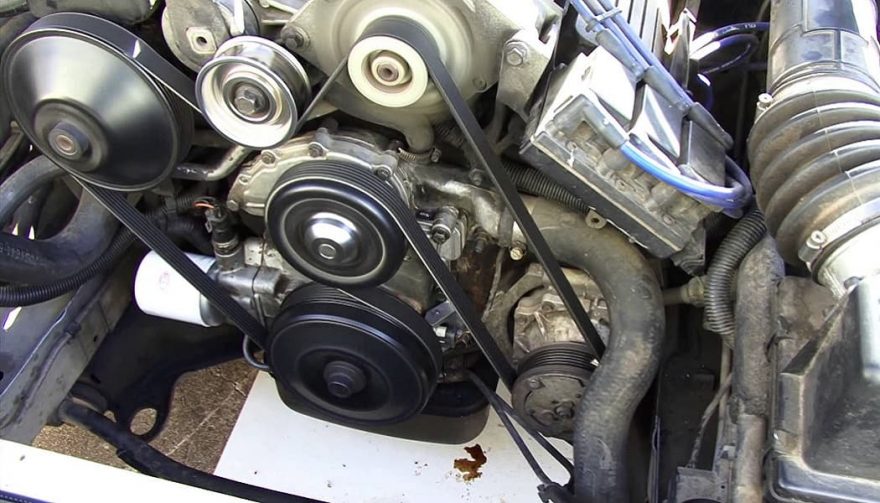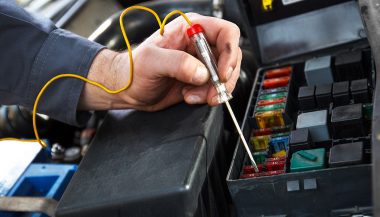
When you replace a fan belt, keep the old one for an emergency spare
How to Replace a Fan Belt: Tips and Tricks
Even if you know almost nothing about cars you can easily learn how to replace a fan belt. Accomplish that simple task and you have instant bragging rights among your friends. And that’s your ante-up into the car maintenance game.
Broken Belts Can Leave You Stranded
A fan belt failure is one of the few breakdowns you can fix yourself on the side of the road. Even if you don’t plan to ever replace the belts yourself, at home or otherwise, it’s still good to know how it’s done. So, let’s become conversant in the operation.
The Old V-Type Belts
You’ve seen these not only on older cars but also on lawn mowers, washing machines, clothes driers and on big floor fans. V-belts work well on equipment that doesn’t turn very fast and that has a lot of room for big diameter pulleys.
V-belts are designated by their measurements, which is width across the top surface in fractions of an inch, and by their length in centimeters. Why the double standard? I don’t know, but I’m sure there is a funny story behind it.
Avoid These Mistakes
Make Sure You Get the Right Size
If the parts store gives you the proper length V-belt, but one in a too-narrow width (it has happened), the narrow belt will ride much lower in the v-shaped groove on its pulley. It won’t have enough traction and it will slip, especially when it stretches with use. If you have problems with power steering belts squealing, suspect you have the wrong belt(s).
Don’t Pry the Belts off
You will see YouTube videos of people replacing fan belts by prying them off the pulleys, then prying the new ones on or by bumping the starter to turn the engine. Don’t do that, as it bends the pulleys, which are made of thin, cheap metal stampings (for V-belts).
Learn where the adjustments are, it’s intuitive, then loosen them, and replace the belts in the safe, proper way. You will very likely have to re-tighten the brand-new belts when they stretch, perhaps after 100 miles. To do that, you have to learn where the adjustments are.
Don’t Install Belts too Tight
Why not just install the new belts a little too tight to allow for stretching? Because that extra tension can rapidly ruin the small bearings in the alternator and water pump. That’s why.
How to Measure Belt Tension
You are supposed to use a tension gauge, which resembles a fishing scale. If you can actually find an ancient tensioner gauge, you would hook it on the midpoint of the longest stretch of belt between two pulleys, and measure how much the belt flexes right there.
It sounds complicated, yes, and besides, you don’t have the gauge. There’s another way to gauge the correct tension. With the engine off, and the key in your pocket, twist the belt at that midpoint. You should be able to twist it about 90 degrees without too much effort. Close enough, especially on a slow-turning V-8 engine.
Your Old Car Might Need a “Matched Set” of Two Belts
Resto-mods are all the rave nowadays, so you might come across some unique technology. Some V8 engines used a double belt system to drive both the alternator and another accessory, where a single belt would not have been strong enough to drive them both. Fine and well.
But a problem will come into play if you install two belts that came off the assembly line days or weeks apart. Even though they might have identical part numbers, their individual lengths can be slightly different. That will cause belt slippage. To avoid that problem, ask for belts that are a “matched set,” meaning they are packaged and sold as a pair, having come off the assembly line together.
New Style Serpentine Belts, New Technology to Learn
As cars became smaller than the two-ton behemoths that once roamed the highways, engine compartments became more compact and cramped. The big diameter V-type pulleys would no longer fit in the smaller spaces. Also, the newer, tiny engines turn at much higher revolutions.
Enter the serpentine belt, which is very common these days. Very thin, they can easily make the short radius bends around small pulleys. To give them traction, they are much wider than V-type belts.
Thin, wide serpentine belts don’t stretch nearly as much as thick, narrow V-belts. Since they don’t have much “give,” so to speak, even a little over-tightening can ruin pulleys and accessory bearings really fast. That’s why they have automatic tensioners, spring loaded pulleys, that keep a constant tension on the belt, even as they wear with use.
You Will Probably Need Special Tools to Replace Your Serpentine Belts
The spring you have to compress to loosen a serpentine belt is extremely powerful, enough to break fingers or a hand if it slings a wrench into flesh. Stay safe working on your car.
Proper tools to leverage the tensioner are inexpensive and readily available at any good parts store. Chances are the right tensioner tool for your car will cost less than the belt itself.
Keep Spares
So, after you replace the belt, keep the old one in the trunk as an emergency spare. On long trips, you might consider taking the tensioner wrench along with you, just in case.
Don’t Get Confused
Ok, it looked so simple, so you took the old serpentine belt off but now you can’t figure how to route the new belt correctly around the myriad pulleys. No problem, even if your car does not have the handy diagram of pulleys and belt routing somewhere under its hood, as many vehicles do.
Google it. Try the belt manufacturer’s website. They post helpful info like that. If not, go back to the parts store and have them pull up a diagram from their data base and print it for you.
Next time, though, draw a simple diagram of the pulleys and belt routing on paper before you take the belt off. Just saying.
Fun Facts
Don’t use V-belts made for lawn equipment on your car. Those belts are not strong enough for high speed, high temperature use on a car engine.
Serpentine belts can last for 100,000 miles. But the small idler and tensioner pulley bearings won’t last 200,000 miles. So, when you replace the serpentine belt, replace the idlers and tensioner pulleys as well. They’re not that expensive, and not worth risking a breakdown.
Lastly, if you can replace your fan belts yourself, you will avoid paying for one or two (or more) hours of labor at your repair shop.





